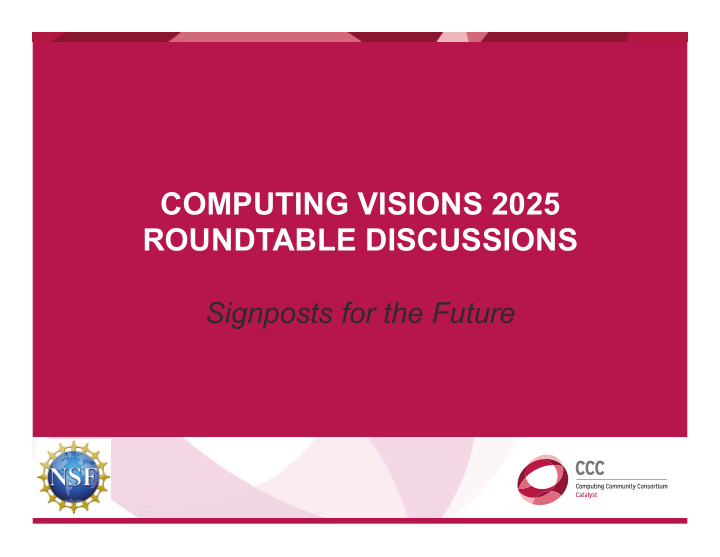



COMPUTING VISIONS 2025 ROUNDTABLE DISCUSSIONS Signposts for the Future
INTERACTING WITH THE COMPUTERS ALL AROUND US The future of interaction among humans, computers, and the physical world: ¥ ! Assist people and empower communities: Communicate, collaborate, organize, for better sustainability and quality of life, in daily life ¥ ! Heterogeneous combinations of assistants: cognitive, physical and social; these tools are networked (Internet of things) and collaborative ¥ ! Challenges : real-time interaction, perception (user, context, environment), recognition (state, activity), modeling (user, situation, interaction dynamics), natural multimodal communication, ubiquitous interfaces, trust, engagement, personalization, privacy, reliability ¥ ! Exciting threads/highlights: broaden beyond the 1 st world (well beyond convenience), focus on children (education, health), connect communities through funding to accelerate progress (HCI-HRI, vision-robotics, social & cog sci, design, ethics ! to computing)
THE NEW MAKING RENAISSANCE Programmable Matter and Things NSF / CRA Vision 2025 Vision Workshop held 2-4 June 2014 Eric Paulos , UC Berkeley David Culler, UC Berkeley Prabal Dutta , University of Michigan James Landay, Cornell Tech / Stanford
NEW MAKING RENAISSANCE: A REVOLUTION? Creativity and change unleashed could fundamentally change how society operates ! !" !" FLEXIBLE UBIQUITOUS DIGITAL ELECTRONICS PROGRAMMING FABRICATION Return to craftsmanship with precision and ability to mass customize/produce
2 MINUTES LIGHTNING INTRODUCTIONS 2 SLIDES Who are you? What do you do? What is the primary Opportunity Challenge Open Question in next 10-20 years
FUTURE HEADLINES ! 15-20 YEARS OUT
HEADLINE BREAKOUT GROUPS TOP HEADLINE TOPICS Robot Termite Builders Genetic Algorithm Wins Furniture Competition Bespoke Digital Tailors Spinal Column Grows with Child Internet of Things Fatigue Bioluminescent Trees
KEY CROSSCUTTING TOPICS Science, Education & Design are Intertwined ¥ ! come at solutions differently, but all are required for innovation ¥ ! just-in-time, lifelong learning & project-based learning key ¥ ! where does higher ed fit in this? http://bouncingideas.wordpress.com/2011/11/12/design-engineering-science-their-differences-through-the-lens-of-biomimicry/ Design Tools are essential to accelerating innovation & productivity ¥ ! tools must work across electronics, physical form & software ¥ ! need tools to promote creativity ¥ ! need tools to help leverage new materials p
KEY CROSSCUTTING TOPICS Micro-manufacturing that scales from small to large to empower small businesses Sustainable infrastructure is necessary ¥ ! maker outputs that are recyclable & reusable ¥ ! how to augment the natural world? Health/Bio applications need modular devices ¥ ! interface w/ bio parts ¥ ! Òbio foundriesÓ ¥ ! abstraction barriers allow designers to focus on their area of expertise ¥ ! shape changing implants
FRAMING THE AGING IN PLACE (TECHNOLOGY) RESEARCH CHALLENGE Elizabeth D. Mynatt Professor, Interactive Computing, Georgia Tech Vice-Chair, Computing Community Consortium Comments based on Sept 2014 NIH CCC Workshop led by Alice Borrelli, Sara Czaja, Jeff Kaye, Dan Sierwiorek, John Stankovic, Elizabeth Mynatt, Erin Iturriaga, Wendy Nielsen
CREATE MODEL OF HUMAN / TECHNICAL SYSTEM #$%&'"()*+,%'"-./,0+%%'"-1/2/"3"4./,$5"67889:"
!"#$%&'()*$+","$ +-*&.,$/((&((0&',$ 3'4&*&'.&$ 3',&*6&'7)'($ 1*"0&#)*5($ ;)<)0" M/ M/$5" =+5+>5),%" N+ N+D)>$5O" Mobility -D$0$>/D" R=B%" B)>/<)0" B) B) B)>/<)0" B) Sleep =+>$%$)0" LR=B%" Hygiene G,/><)0" P% P P%<H/<)0" 4IFF),5" PR=B%" " 4D+ 4D++F" B)/C"-+DD%"?" Socialization -/,+" E+C"4+0%),%" #,/$D5O" -)),C$0/<)0" Depression =+ =+F/,5I,+%" -)05/>5?=))," R, R,,$Q/D%" 4@$5>.+%" Memory A. A.)0+"K%+" A.)0+" -.,)0$>" (+./U$D$5/<)0" 4+0%),%" C$%+/%+" Attention H/0/*+H+05" -)HFI5+," - -) -)*0$<Q+" -)HFI5+," Medication L05 L05+,/><)0%" %IFF),5" Adherence L0C+F+0C+0>+" ;+C$>/<)0" ; ; ;+C$>/<)0" 4)>$/D"%IFF),5" SI/D$5O")T"D$T+" PQ+05%" PQ G,/>&+," Physical Impairments J+$*.5" J J+$*.5" 3 4 3 4 3'4)$ %&'()*$ %&'()*$ 4>/D+" 12(-)'$ 12(-)'$
WORKSHOP RECOMMENDATIONS -)HFD+V"W++C%" =+%$*0$0*"T),"" 4+0%$0*'"R>5I/<)0"/0C" X+/D5."G,/0%$<)0" 4O%5+H"L05+*,/<)0" G,/2+>5),$+%"" G+>.0)D)*O"" " RC/F5/UD+"%O%5+H%"" P0*/*+H+05"" ;)0$5),$0*"" XIH/0Y-+05,$>"=+%$*0"" K%+,";)C+D$0*"" 4O%5+H"(+%$D$+0>+"" -/,+YW+5@),&%"" A,$Q/>O"/0C"K%+," A,+C$><Q+"/0C"=+>$%$)0" R>>+F5/0>+"" R0/DO<>%"" #I5I,+YA,))Z0*"" 8"**-&*($ G.+"0++C"T),"/><)0/UD+"+Q$C+0>+" ¥ ! G.+"0++C"T),"$0T),H/<)0"C$%%+H$0/<)0"5./5"U,$C*+%"5.+"*/F"" ¥ ! U+5@++0",+%+/,>."/0C"F,/><>+" G.+"0++C"T),"+[+><Q+"5,/0%YC$%>$FD$0/,O">)DD/U),/<)0" ¥ ! G.+"0++C"T),"T/,Y,+/>.$0*"5+%5"U+C%" ¥ ! "
UNCERTAINTY AND COMPUTATION Bill Thompson Ross Whitaker University of Utah
WE LIVE IN THE AGE OF DATA ¥ ! 4>$+0>+'"5+>.0)D)*O'"/0C"F)D$<>%"F+,H+/5+C" UO"$0T),H/<)0"5./5">)H+%"T,)H"F+)FD+'" H+/%I,+H+05%'"),">)HFI5/<)0/D"F,)>+%%+%" ¥ ! ;)%5"$HF),5/05"C+>$%$)0%"U/%+C")0"C/5/" F,)>+%%+C"/0C"F,+%+05+C"UO">)HFI5+,%" Ð ! =/5/"$%"$0+Q$5/UDO"$HF+,T+>5\"$0>)HFD+5+'">),,IF5'" D/>&$0*"$0"/>>I,/>O"/0C"F,+>$%$)0" Ð ! PVFD$>$5">)0%$C+,/<)0")T"I0>+,5/$05O",/,+DO"F/,5")T" 5.+">)HFI5/<)0/D"/0C"C+>$%$)0"H/&$0*"F$F+D$0+"
UNCERTAINTY IS A FACT OF LIFE ]J.+0"/DD"$%"%/$C"/0C"C)0+'"5.+"@+/5.+,"/0C"D)Q+"/,+"5.+"5@)" +D+H+05%"/U)I5"@.$>.")0+">/0"0+Q+,"U+"%I,+^_"" `"RD$>+"X)[H/0'" !"#"$%&$'(#)* "
FROM ANSWERS TO INFORMED DECISIONS N$%I/D$1/<)0" N N$%I/D$1/<) R"-)HFI5/<)0/D"a 5. "P%5/5+b" WIH+,$>%" 4>$+0<Z>"-)HFI<0*" A+,>+F<)0?A%O>.)D)*O" 4$HID/<)0" 4>$+0>+" =+>$%$)0" -)HHI0$>/<)0" - ;/&$0*" =/5/" 4>$+0>+" =+>$%$)0"4>$+0>+" 45/<%<>%" ;/>.$0+"B+/,0$0*" =/5/";$0$0*" 9'.&*,"-',: "/%"/"#$,%5Y-D/%%"-$<1+0"
BRAIN Papadimitriou, Rabin, Hager, Whang, Schaal, Golland, Koch, Pfister, Tennenbaum
BRAIN D<E%*&56%)*= 2B&5)99)"*&:"6>):%9&*4<6"*7 2?21&>$"<7%*#&:"**4:>)"*7@*4<6"* F&E)99)"*&:"6>):%9&:"9<E*7&G F11&%64%7&%*#&*<:94)G 20111&)*>46?%64%9&:"**4:>)"*7G ! ¥ ! X)@"C)+%"5.+"U,/$0"C)"@./5"$5"C)+%b"" Ð ! R,>.$5+>5I,/D"H)<T%"Yc"TI0><)0/D"H)<T%" ¥ ! -/0"@+"UI$DC"H+/0$0*TID",+T+,+0>+"H)C+D%" 5./5"I0$5+"C$[+,+05"%>/D+%?H)C/D$<+%? >)HHI0$<+%" ¥ ! -/0"@+"%>/D+"5.$%"5)"U+"H+/0$0*TIDb" ¥ ! J./5"C)+%"5.$%"5+/>."I%"/U)I5">)HFI5/<)0b"
Recommend
More recommend